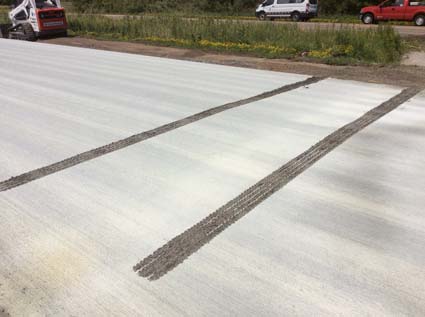NRRA Newsletter: October 2017
NRRA Grand Opening Celebration
If you missed our open house on Oct. 10, here are the highlights.
NRRA Associate Member Profile: American Engineering Testing (AET)
Since the recession, AET has been growing considerably. It has almost doubled in size with more than 400 employees and 20 offices. While the company name suggests they do a lot of testing, Derek Tompkins, PhD, PE, Principal Civil Engineer, says much of the demand for AET’s services comes from consultation, design development (but not construction plans), how to use local materials and how to optimize the performance of those local materials.
As an organization that provides extensive testing for the pavement construction industry, the growth of cold recycled asphalt is a front-burner issue for AET. Both cold in-place recycled pavements and cold plant recycled pavements are increasingly in demand by city, county and state road owners.
For AET, the testing of recycled asphalt pavements presents new challenges. Testing for the fracture energy of virgin asphalt pavements is well established--not so with recycled asphalt, says Tompkins. Tests such as the circular bend test, semicircular bend test, and the direct compact tension test were all developed to determine the fracture energy of virgin materials. Now AET is investigating how these performance tests can be applied to this whole new range of asphalt products.
“All the sophistication in design, all the modeling, all the different ways you have to quantify your materials--they are all really great. If you are not building pavement in the right way to start with, you’re not going to get much of a pavement no matter what your design looks like, no matter what your materials look like.”
--Derek Tompkins
One of Tompkins’s colleagues Eyoab Zegeye, Ph.D. at AET has a published paper on that topic in an upcoming issue of Road Materials and Pavement Design titled “Application of Laboratory Asphalt Cracking Tests to Cold In-place Recycled Mixtures.”
Because AET sees so many paving projects in a given year, its employees have a rather unique perspective on the paving industry. Tompkins himself says of the evolving paving industry, “the thing we come back to, again and again, is that you can quantify your materials with laboratory testing as much as you like, but uniformity in production and construction and good quality construction practices can’t be beat. If you have good construction practices, you will generally wind up with good pavement. So even though we do a lot of very strategic engineering testing and engineering analysis, one service we can assist with that can’t be overlooked is construction quality monitoring—making sure that the things that are supposed to happen in constructed pavement are the things that happen.”
Shorthand—construction quality matters.
Tompkins also stresses that the quality of the base and subgrade will, time and time again, determine how long your pavement lasts. “If you construct your base and subgrade well, whether you have eight inches or nine inches or ten inches of asphalt or concrete or whatever on top of it, you’re going to find out what’s underneath the pavement has just as much to do with the long-term performance. Just give it time,” says Tompkins.
And yes, this will be on the test.
MnROAD Summer Construction Updates
We have a video playlist of all our construction updates (18) on YouTube. Check them out.
Early Loading Concrete Test Cell: MnROAD Experiment Could be a Game Changer
As part of the National Road Research Alliance’s research this summer, one of the test cells is an experiment involving early loading of a concrete pavement. This experiment seeks to answer some important questions including how early concrete pavements may be open to traffic after construction.
As Matt Zeller, Executive Director of Concrete Paving Association of Minnesota, describes it, the concrete industry has been asking the question for decades: “when can we open concrete pavements to traffic.” Currently, he explains, MnDOT has a specification that the concrete pavements can be opened to traffic when it is at 3,000 psi compressive strength, but that can take a while. Dr. Bernard Izevbekhai, Research Operations Engineer for MnDOT, oversaw the experiment. He says that, depending on the temperature, weather, and mix design, it can take from 7 to 28 days to open a concrete pavement to traffic, and that has huge implications on user costs that add to the overall cost. The question is what strength do we really need to open these roads to traffic?
To answer these questions, in summer 2017, MnDOT and the other NRRA collaborators decided to conduct a real-time experiment at the MnROAD research facility to determine strength of concrete when opening it to traffic. Researchers pushed the limits a bit by loading the newly constructed pavements early.
The Experiment
Izevbekhai explains for us how the experiment proceeded in the MnROAD Low Volume test track. In the experimental design there were four cells that would be sequentially loaded and a fifth that would act as the control. In a sixth cell ruts were inflicted across the plastic pavement to study the impact of visible ruts when drivers erroneously drive on freshly placed pavements. There were two lanes--one lane hosted a ¾ ton pickup truck and the other lane would have a MnDOT snow plow driving on it.
As soon as the pavement was placed and instrumented, the load testing and analysis followed. The research team, explains Izevbekhai, performed early loading in a sequence based on maturity of the concrete. Maturity is calculated or read as a function of internal temperature of the concrete and time. When the pavement reached 100 degree Celsius-hour (100 °C-Hr.), they drove the trucks on cell 124 right up to the edge of the cell and then reversed back over it. Likewise when the maturity reached 200 °C-Hr., cell 224 was tested. This proceeded in a similar fashion until all four cells were loaded. That meant cell 124 had eight passes from each vehicle and cell 424 had two.
Because they were not simply judging the readiness of the concrete by time, the maturity measure didn’t create a perfectly predictable schedule for the researchers. Consequently, because the pavement was installed on a hot day, Izevbekhai and his team were up all night testing the sections, making calculations and gathering data from the sensors.
Damage is complicated
 |
Cell 624: MnROAD personnel conducted early life load testing throughout the day. This included passage of a ¾-ton pickup approximately 2 hours after placement (to induce visible damage). |
Essentially the experiment involves calculation of damage to the concrete pavement when you load it early, but damage is multifaceted. At first glance, there wasn’t much to see. The damage formulae algorithms and software Izevbekhai’s team is using projects how much the early loading would affect the longevity of the concrete. It includes the early loading, the mix and climatic factors as input.
They also did a lot of testing. They cut cores in each cell and monitored for warp and curl, as well as ruts in the wheel path. They monitored the installed sensors as the trucks loaded each cell. Finally they used a MIRA, an Ultrasonic Low Frequency Tomograph, which they borrowed from NRRA member the University of Minnesota. This non-destructive test, explains Izevbekhai, can determine if the consistency of the concrete has been compromised.
All of this data collection and analysis will take some time, and the University of Pittsburg, also an NRRA member, will be the principal investigator during the analysis of all the data gathered.
Autogenous Healing
MIRA helps to detect the overall condition of the interior of the pavement. Petrographic analysis will show if aggregates have been pushed apart by early loading. That is important because of autogenous healing. If the aggregate isn’t pushed too far apart, Izevbekhai says, concrete that is disturbed while in its plastic state can heal as the hydration reaction continues.
He thinks they may have had some of this during the testing. During the first pass, the sensors detected a lot of stress and deflection in the first cell. But on the second pass over that cell, strain was dramatically reduced in some sensors. Izevbekhai attributes this phenomenon to autogenous healing.
Too early to tell, but…
All the caveats are in place about jumping to conclusions about this experiment. That said, early results were encouraging, says Zeller, since no visible damage was detected. Early loading of concrete pavements, he explains, is not just a theory—it happens all the time in the real world of road construction. Often, he says, locals will drive on concrete early, bypassing barriers. Then engineers will argue that it’s been compromised and must be replaced whether or not any damage is done. This research will help make better decisions about these instances.
“We want everyone to start thinking about this because it’s going to really shake some trees. It’s not conventional,” he says. “My gut says we are going to have to completely rewrite how we open our concrete slabs,” adds Zeller.
If this is a game changer for the concrete paving industry, this experiment could save a lot in terms of project cost. It could also improve the mood of the traveling public when roads are opened early.
November Research Pays Off Webinar
Nov. 21--Chris Williams, Gerald & Audrey Olson Professor of Civil Engineering and Director of the Asphalt Materials & Pavements Program, Iowa State University.
Topic: Biomaterials and Biopolymers
This will be a broad overview of the various biomaterials that are in various stages of implementation followed by a deep dive into the biopolymers. We will examine epoxidized methyl soyate (EMS) that's being used in the Nantes accelerated test facility. We have also tried EMS with 30% RAP on a county project in Iowa--the contractor had great field voids that resulted in a 4% bonus. We are now looking at using the EMS with a 30% RAP surface mix (quartzite) on US-18 (higher volume road) in the next couple of weeks. We are hoping to implement biopolymers on test/demo projects next construction season--as early as April/May.
Connection information for Webinar


